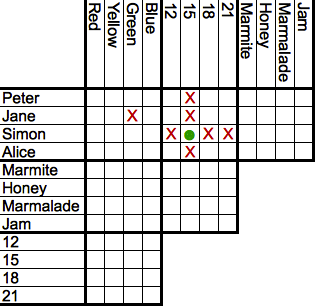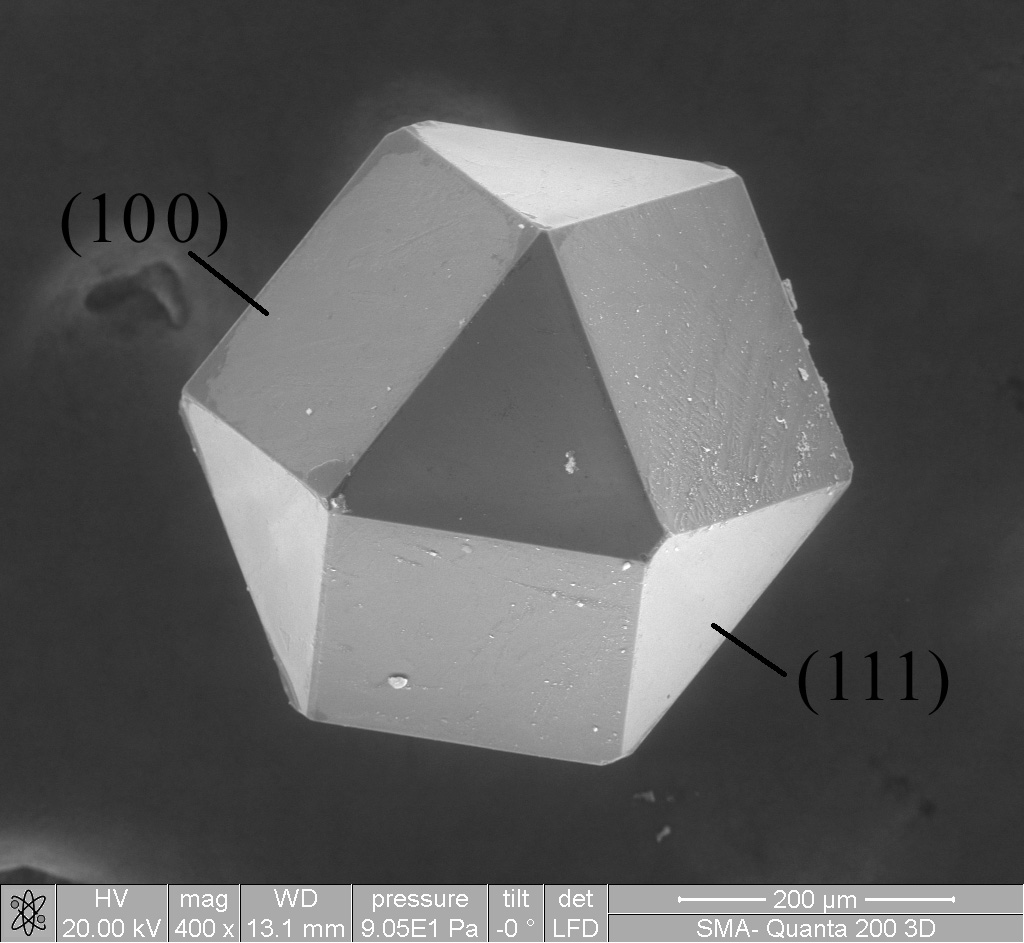|
Discrete Tomography
Discrete tomographyHerman, G. T. and Kuba, A., Discrete Tomography: Foundations, Algorithms, and Applications, Birkhäuser Boston, 1999 Herman, G. T. and Kuba, A., Advances in Discrete Tomography and Its Applications, Birkhäuser Boston, 2007 focuses on the problem of reconstruction of binary images (or finite subsets of the integer lattice) from a small number of their projections. In general, tomography deals with the problem of determining shape and dimensional information of an object from a set of projections. From the mathematical point of view, the object corresponds to a function and the problem posed is to reconstruct this function from its integrals or sums over subsets of its domain. In general, the tomographic inversion problem may be continuous or discrete. In continuous tomography both the domain and the range of the function are continuous and line integrals are used. In discrete tomography the domain of the function may be either discrete or continuous, and the ran ... [...More Info...] [...Related Items...] OR: [Wikipedia] [Google] [Baidu] |
Flow Network
In graph theory, a flow network (also known as a transportation network) is a directed graph where each edge has a capacity and each edge receives a flow. The amount of flow on an edge cannot exceed the capacity of the edge. Often in operations research, a directed graph is called a network, the vertices are called nodes and the edges are called arcs. A flow must satisfy the restriction that the amount of flow into a node equals the amount of flow out of it, unless it is a source, which has only outgoing flow, or sink, which has only incoming flow. A flow network can be used to model traffic in a computer network, circulation with demands, fluids in pipes, currents in an electrical circuit, or anything similar in which something travels through a network of nodes. As such, efficient algorithms for solving network flows can also be applied to solve problems that can be reduced to a flow network, including survey design, airline scheduling, image segmentation, and the matching prob ... [...More Info...] [...Related Items...] OR: [Wikipedia] [Google] [Baidu] |
Logic Puzzle
A logic puzzle is a puzzle deriving from the mathematics, mathematical field of deductive reasoning, deduction. History The logic puzzle was first produced by Charles Lutwidge Dodgson, who is better known under his pen name Lewis Carroll, the author of ''Alice's Adventures in Wonderland''. In his book ''The Game of Logic'' he introduced a game to solve problems such as confirming the conclusion "Some greyhounds are not fat" from the statements "No fat creatures run well" and "Some greyhounds run well". Puzzles like this, where we are given a list of premises and asked what can be deduced from them, are known as syllogisms. Dodgson goes on to construct much more complex puzzles consisting of up to 8 premises. In the second half of the 20th century mathematician Raymond Smullyan, Raymond M. Smullyan continued and expanded the branch of logic puzzles with books such as ''The Lady or the Tiger?'', ''To Mock a Mockingbird'' and ''Alice in Puzzle-Land''. He popularized the "knights a ... [...More Info...] [...Related Items...] OR: [Wikipedia] [Google] [Baidu] |
Nonogram
Nonograms, also known as Hanjie, Paint by Numbers, Griddlers, Pic-a-Pix, and Picross, are picture logic puzzles in which cells in a grid must be colored or left blank according to numbers at the edges of the grid to reveal a hidden picture. In this puzzle, the numbers are a form of discrete tomography that measures how many unbroken lines of filled-in squares there are in any given row or column. For example, a clue of "4 8 3" would mean there are sets of four, eight, and three filled squares, in that order, with at least one blank square between successive sets. These puzzles are often black and white—describing a binary image—but they can also be colored. If colored, the number clues are also colored to indicate the color of the squares. Two differently colored numbers may or may not have a space in between them. For example, a black four followed by a red two could mean four black boxes, some empty spaces, and two red boxes, or it could simply mean four black boxes foll ... [...More Info...] [...Related Items...] OR: [Wikipedia] [Google] [Baidu] |
3DXRD
Three-dimensional X-ray diffraction (3DXRD) is a microscopy technique using hard X-rays (with energy in the 30-100 keV range) to investigate the internal structure of polycrystalline materials in three dimensions. For a given sample, 3DXRD returns the shape, juxtaposition, and orientation of the crystallites (''"grains"'') it is made of. 3DXRD allows investigating micrometer- to millimetre-sized samples with resolution ranging from hundreds of nanometers to micrometers. Other techniques employing X-rays to investigate the internal structure of polycrystalline materials include X-ray diffraction contrast tomography (DCT) and high energy X-ray diffraction (HEDM). Compared with destructive techniques, e.g. three-dimensional electron backscatter diffraction (3D EBSD), with which the sample is serially sectioned and imaged, 3DXRD and similar X-ray nondestructive techniques have the following advantages: * They require less sample preparation, thus limiting the introduction of new struct ... [...More Info...] [...Related Items...] OR: [Wikipedia] [Google] [Baidu] |
Materials Science
Materials science is an interdisciplinary field of researching and discovering materials. Materials engineering is an engineering field of finding uses for materials in other fields and industries. The intellectual origins of materials science stem from the Age of Enlightenment, when researchers began to use analytical thinking from chemistry, physics, and engineering to understand ancient, phenomenological observations in metallurgy and mineralogy. Materials science still incorporates elements of physics, chemistry, and engineering. As such, the field was long considered by academic institutions as a sub-field of these related fields. Beginning in the 1940s, materials science began to be more widely recognized as a specific and distinct field of science and engineering, and major technical universities around the world created dedicated schools for its study. Materials scientists emphasize understanding how the history of a material (''processing'') influences its struc ... [...More Info...] [...Related Items...] OR: [Wikipedia] [Google] [Baidu] |
Sara Bals
Sara Bals (born 1977) is a Belgian nanoscientist known for her research on electron tomography and its application in the study of nanomaterials such as perovskite nanocrystals. She is a professor of electron microscopy for materials science at the University of Antwerp. Education and career Bals was born 25 August 1977 in Antwerp. She was educated in physics at the University of Antwerp, earning a master's degree in 1999 and completing her Ph.D. there in 2003. Her dissertation was ''Optimisation of superconducting thin films and tapes by transmission electron microscopy''. After postdoctoral research in the National Center for Electron Microscopy at Lawrence Berkeley National Laboratory and at the University of Antwerp, she became an assistant professor at the University of Antwerp in 2007. She was promoted to associate professor in 2012 and full professor in 2018. Recognition Bals was elected to the Royal Flemish Academy of Belgium for Science and the Arts The Royal Flem ... [...More Info...] [...Related Items...] OR: [Wikipedia] [Google] [Baidu] |
Electron Microscopy
An electron microscope is a microscope that uses a beam of electrons as a source of illumination. It uses electron optics that are analogous to the glass lenses of an optical light microscope to control the electron beam, for instance focusing it to produce magnified images or electron diffraction patterns. As the wavelength of an electron can be up to 100,000 times smaller than that of visible light, electron microscopes have a much higher resolution of about 0.1 nm, which compares to about 200 nm for light microscopes. ''Electron microscope'' may refer to: * Transmission electron microscope (TEM) where swift electrons go through a thin sample * Scanning transmission electron microscope (STEM) which is similar to TEM with a scanned electron probe * Scanning electron microscope (SEM) which is similar to STEM, but with thick samples * Electron microprobe similar to a SEM, but more for chemical analysis * Low-energy electron microscope (LEEM), used to image surfaces * ... [...More Info...] [...Related Items...] OR: [Wikipedia] [Google] [Baidu] |
Medicine
Medicine is the science and Praxis (process), practice of caring for patients, managing the Medical diagnosis, diagnosis, prognosis, Preventive medicine, prevention, therapy, treatment, Palliative care, palliation of their injury or disease, and Health promotion, promoting their health. Medicine encompasses a variety of health care practices evolved to maintain and restore health by the prevention (medical), prevention and treatment of illness. Contemporary medicine applies biomedical sciences, biomedical research, medical genetics, genetics, and medical technology to diagnosis (medical), diagnose, treat, and prevent injury and disease, typically through pharmaceuticals or surgery, but also through therapies as diverse as psychotherapy, splint (medicine), external splints and traction, medical devices, biologic medical product, biologics, and Radiation (medicine), ionizing radiation, amongst others. Medicine has been practiced since Prehistoric medicine, prehistoric times, and ... [...More Info...] [...Related Items...] OR: [Wikipedia] [Google] [Baidu] |
Image Processing
An image or picture is a visual representation. An image can be two-dimensional, such as a drawing, painting, or photograph, or three-dimensional, such as a carving or sculpture. Images may be displayed through other media, including a projection on a surface, activation of electronic signals, or digital displays; they can also be reproduced through mechanical means, such as photography, printmaking, or photocopying. Images can also be animated through digital or physical processes. In the context of signal processing, an image is a distributed amplitude of color(s). In optics, the term ''image'' (or ''optical image'') refers specifically to the reproduction of an object formed by light waves coming from the object. A ''volatile image'' exists or is perceived only for a short period. This may be a reflection of an object by a mirror, a projection of a camera obscura, or a scene displayed on a cathode-ray tube. A ''fixed image'', also called a hard copy, is one that ... [...More Info...] [...Related Items...] OR: [Wikipedia] [Google] [Baidu] |
Monte Carlo Algorithm
In computing, a Monte Carlo algorithm is a randomized algorithm whose output may be incorrect with a certain (typically small) probability. Two examples of such algorithms are the Karger–Stein algorithm and the Monte Carlo algorithm for minimum feedback arc set. The name refers to the Monte Carlo casino in the Principality of Monaco, which is well-known around the world as an icon of gambling. The term "Monte Carlo" was first introduced in 1947 by Nicholas Metropolis. Las Vegas algorithms are a dual of Monte Carlo algorithms and never return an incorrect answer. However, they may make random choices as part of their work. As a result, the time taken might vary between runs, even with the same input. If there is a procedure for verifying whether the answer given by a Monte Carlo algorithm is correct, and the probability of a correct answer is bounded above zero, then with probability one, running the algorithm repeatedly while testing the answers will eventually give a co ... [...More Info...] [...Related Items...] OR: [Wikipedia] [Google] [Baidu] |
Greedy Algorithm
A greedy algorithm is any algorithm that follows the problem-solving heuristic of making the locally optimal choice at each stage. In many problems, a greedy strategy does not produce an optimal solution, but a greedy heuristic can yield locally optimal solutions that approximate a globally optimal solution in a reasonable amount of time. For example, a greedy strategy for the travelling salesman problem (which is of high computational complexity) is the following heuristic: "At each step of the journey, visit the nearest unvisited city." This heuristic does not intend to find the best solution, but it terminates in a reasonable number of steps; finding an optimal solution to such a complex problem typically requires unreasonably many steps. In mathematical optimization, greedy algorithms optimally solve combinatorial problems having the properties of matroids and give constant-factor approximations to optimization problems with the submodular structure. Specifics Greedy algori ... [...More Info...] [...Related Items...] OR: [Wikipedia] [Google] [Baidu] |





